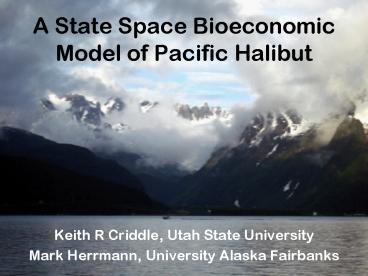A State Space Bioeconomic Model of Pacific Halibut - PowerPoint PPT Presentation
1 / 29
Title:
A State Space Bioeconomic Model of Pacific Halibut
Description:
A State Space Bioeconomic Model of Pacific Halibut. Keith R Criddle, Utah State University ... Halibut Landings. IPHC regulatory areas ... – PowerPoint PPT presentation
Number of Views:37
Avg rating:3.0/5.0
Title: A State Space Bioeconomic Model of Pacific Halibut
1
A State Space Bioeconomic Model of Pacific Halibut
- Keith R Criddle, Utah State University
- Mark Herrmann, University Alaska Fairbanks
2
Halibut Landings
3
IPHC regulatory areas
4
Approximate Structural Model with Aoki State
Space Time Series Error Correction
5
Model Solution
- GLS solution to equation 1
- GLS solution to equation 2 with bias correction
- Aoki State Space Time Series Analysis solution to
equations 3 4 - Iterate steps 1, 2, and 3 until parameter
estimates converge
6
Convergence of Parameter Estimates
Stock Dynamics
Recruitment
7
Stock Dynamics
8
Recruitment Dynamics
9
State and Observation Equations
10
Decay Path of Latent Variables
11
Gain from State Space Error Correction Procedure
12
Expected Sustainable Yields
13
Expected Recruitment
14
Sustainable Yield and Recruitment 10 Change
in Productivity
15
Sustainable Yield and Recruitment 10 Change
in Recruitment
16
Sustainable Yield and Recruitment 5 Change
in Growth Rate
17
Product and Financial Flows in the Halibut Market
18
Market Model
- US Wholesale Demand R2 0.871
- US Inventories R2 0.446
- BC Exports R2 0.795
- BC Export Price R2 0.946
- AK Exvessel Demand R2 0.899
- BC Exvessel Demand R2 0.882
19
Economic Effects of IFQs
20
Expected Effects of Season Elongation
21
Expected Effects of Increased Aquaculture
22
Sustainable Exvessel Revenues 10 Change in
Productivity
23
Sustainable Exvessel Revenues 10 Change in
Productivity
24
Sustainable Exvessel Revenues 10 Change in
Recruitment
25
Sustainable Exvessel Revenues 10 Change in
Recruitment
26
Sustainable Exvessel Revenues 5 Change in
Growth Rate
27
Sustainable Exvessel Revenues 5 Change in
Growth Rate
28
What Next?
- Age/Sex structure to stock and recruitment
dynamics - Spatial structure to stock and recruitment
dynamics - Use ENSO instead of PDO to gain from lag
- Include model production costs
- Stochastic Optimal Control of catches and
inventories
29
The End































